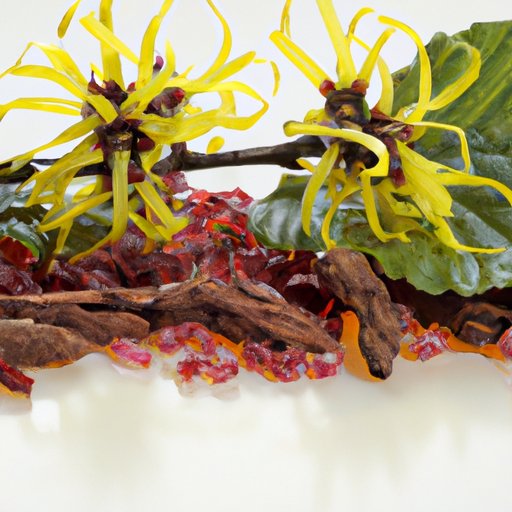Introduction
Witch hazel is an herbal remedy derived from the leaves, bark, and twigs of the North American witch hazel shrub. It has been used for centuries to treat a variety of ailments, including acne. But does witch hazel really help acne? In this article, we’ll explore the available evidence about witch hazel and its potential for treating acne.
Definition of Witch Hazel
Witch hazel is a plant native to North America and parts of Asia. It grows in moist forests, streamsides, and along roadsides. The leaves, bark, and twigs of the witch hazel shrub contain tannins, flavonoids, and volatile oils that have astringent, anti-inflammatory, and antioxidant properties. Witch hazel is commonly used as a topical remedy for skin conditions such as acne, eczema, psoriasis, and sunburns.
Overview of Acne and its Causes
Acne is a common skin condition that affects people of all ages. It is caused by a combination of factors, including hormones, genetics, and the environment. Acne typically appears as red bumps, blackheads, whiteheads, or cysts on the face, neck, chest, back, and shoulders. It can cause physical discomfort, embarrassment, and low self-esteem.
Investigating the Benefits of Witch Hazel for Treating Acne
Historical Uses of Witch Hazel
Witch hazel has been used for centuries to treat a variety of ailments, including skin conditions such as acne. Native Americans and early settlers used it to treat cuts, bruises, and other skin irritations. In the 19th century, witch hazel was widely used as a topical remedy for a range of skin issues.
How Witch Hazel Works to Treat Acne
Witch hazel works by reducing inflammation and irritation. Its astringent properties help reduce oiliness and unclog pores. It also contains antioxidants that may help protect the skin from environmental damage. Additionally, witch hazel is thought to help reduce bacteria on the skin, which can help prevent breakouts.
What Research Says About Witch Hazel and Acne
Studies have found that witch hazel can be effective at reducing inflammation and killing bacteria on the skin. However, there is limited evidence on its effectiveness in treating acne specifically. One study found that witch hazel extract was effective at reducing inflammation and redness caused by acne, but more research is needed to determine its long-term effectiveness.

A Comprehensive Guide to Using Witch Hazel for Acne Treatment
Different Types of Witch Hazel Products
Witch hazel is available in various forms, including creams, gels, lotions, soaps, and liquid extracts. Most products are made from a concentrated form of witch hazel extract. These products can be found in drugstores, health food stores, and online retailers.
How to Use Witch Hazel for Acne
To use witch hazel for acne, cleanse the affected area with mild soap and water. Pat the skin dry and apply a thin layer of witch hazel extract to the area. Leave it on for 10-15 minutes and then rinse off with warm water. Repeat this process twice daily until the acne clears up.
Common Side Effects of Witch Hazel
Witch hazel is generally considered safe for most people, but it can cause some side effects. These include skin irritation, stinging, and burning. If you experience any of these side effects, discontinue use and consult your doctor.

What You Need to Know About Witch Hazel and Acne
Considerations Before Using Witch Hazel
Before using witch hazel for acne, it’s important to speak with your doctor or dermatologist. They can advise you on the best course of action for your individual situation. Additionally, it’s important to follow the directions on the product label and take caution when applying it to sensitive areas of the skin.
Other Natural Alternatives to Treat Acne
In addition to witch hazel, there are several other natural remedies that may be effective in treating acne. These include tea tree oil, aloe vera, apple cider vinegar, and green tea extract. As with witch hazel, it’s important to speak with your doctor before trying any of these treatments.

Exploring the Pros and Cons of Witch Hazel for Acne Sufferers
Pros of Using Witch Hazel for Acne
- It is a natural remedy that is widely available and affordable.
- It is gentle enough to use on sensitive skin.
- It has anti-inflammatory and antioxidant properties that may help reduce acne.
- It is easy to use and can be applied directly to the skin.
Cons of Using Witch Hazel for Acne
- There is limited evidence on its effectiveness in treating acne.
- It can cause skin irritation, stinging, and burning in some people.
- It may not be suitable for severe cases of acne.
Does Witch Hazel Really Help Acne? An Evidence-Based Analysis
Summary of Research Findings
The available evidence suggests that witch hazel may be effective in reducing inflammation and killing bacteria on the skin. However, there is limited evidence on its effectiveness in treating acne specifically. More research is needed to determine the long-term efficacy of witch hazel for acne.
Final Thoughts on Witch Hazel and Acne
Although there is limited evidence on the effectiveness of witch hazel for acne, it may be worth trying as a natural alternative. However, it’s important to speak with your doctor before starting any new treatment. Additionally, it’s essential to follow the directions on the product label and take caution when applying it to sensitive areas of the skin.
Conclusion
Witch hazel is a popular herbal remedy that has been used for centuries to treat a variety of ailments, including acne. Although there is limited evidence on its effectiveness in treating acne, it may be worth trying as a natural alternative. However, it’s important to speak with your doctor before starting any new treatment and to take caution when applying it to sensitive areas of the skin.


